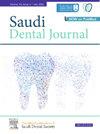The accuracy of digital scanners versus conventional impression in patients with cleft lip and palate: A cross-sectional study
IF 2.3
Q3 DENTISTRY, ORAL SURGERY & MEDICINE
引用次数: 0
Abstract
Background and Objectives
As the use of digital models has expanded across numerous fields, the accuracy of three-dimensional images captured by various intraoral scanners has become a key research focus. This study aimed to evaluate the accuracy of digital scanners (TRIOS 4, iTero Element 5D, and E2) compared with the conventional impression method (gold standard) in patients with cleft lip and palate.
Materials and Methods
Impressions were taken from 20 patients using these scanners and alginate impressions during the same session. Additionally, plaster models were created and scanned using an E2 scanner, and 50 parameters were measured using a digital caliper. All digital models were then analyzed using 3Shape software. Measurement reliability and differences among the four methods were assessed by repeated measures analysis of variance (ANOVA), followed by post-hoc analysis. Subsequently, best-fit superimposition was performed to verify the deviated areas between the digital models.
Results
The plaster cast measurements and digital models obtained using three different scanners revealed high reliability (0.94–1.00). Statistically significant differences between the dental models were observed in 20 out of 50 parameters (p < 0.05). Mean differences in hard tissue parameters between groups ranged from −0.47 to 0.32 mm. Soft tissue parameters revealed more considerable mean differences, ranging from −1.59 to 2.55 mm. The measured palatal depth obtained from digital models was significantly higher, while the depth of the oronasal fistula was significantly lower compared to plaster models.
Conclusion
This study concluded that digital scanners have accuracy comparable to conventional methods, except for depth-related soft tissue parameters, which exhibited a high level of discrepancy.
数字扫描仪与传统印模在唇腭裂患者中的准确性:一项横断面研究
背景与目的随着数字模型在许多领域的应用,各种口腔内扫描仪捕获的三维图像的准确性已成为一个关键的研究热点。本研究旨在评估数字扫描仪(TRIOS 4, iTero Element 5D和E2)与传统印模法(金标准)在唇腭裂患者中的准确性。材料和方法在同一疗程中使用这些扫描仪和海藻酸盐印模对20例患者进行了印模。此外,还制作了石膏模型,使用E2扫描仪进行扫描,并使用数字卡尺测量了50个参数。然后使用3Shape软件对所有数字模型进行分析。采用重复测量方差分析(ANOVA)评估四种方法的测量信度和差异,然后进行事后分析。然后,进行最佳拟合叠加,验证数字模型之间的偏差面积。结果采用三种不同扫描器获得的石膏模型和数字模型具有较高的可靠性(0.94-1.00)。50个参数中有20个在牙模型之间有统计学显著差异(p <;0.05)。各组间硬组织参数的平均差异为- 0.47 ~ 0.32 mm。软组织参数显示出更大的平均差异,范围从- 1.59到2.55 mm。与石膏模型相比,数字模型获得的测量腭深度明显较高,而口鼻瘘深度明显较低。结论除了深度相关的软组织参数存在较大差异外,数字扫描仪具有与传统方法相当的准确性。
本文章由计算机程序翻译,如有差异,请以英文原文为准。
求助全文
约1分钟内获得全文
求助全文
来源期刊

Saudi Dental Journal
DENTISTRY, ORAL SURGERY & MEDICINE-
CiteScore
3.60
自引率
0.00%
发文量
86
审稿时长
22 weeks
期刊介绍:
Saudi Dental Journal is an English language, peer-reviewed scholarly publication in the area of dentistry. Saudi Dental Journal publishes original research and reviews on, but not limited to: • dental disease • clinical trials • dental equipment • new and experimental techniques • epidemiology and oral health • restorative dentistry • periodontology • endodontology • prosthodontics • paediatric dentistry • orthodontics and dental education Saudi Dental Journal is the official publication of the Saudi Dental Society and is published by King Saud University in collaboration with Elsevier and is edited by an international group of eminent researchers.
 求助内容:
求助内容: 应助结果提醒方式:
应助结果提醒方式:


